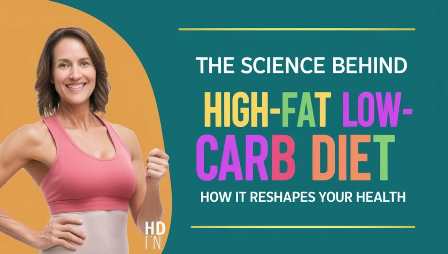Keto, or ketogenic diet, is a pleasant method of weight loss that involves reducing carbs and adopting a high-fat, low-carb diet strategy. The objective is to limit carbohydrate consumption and replace it with fat, causing the body to enter ketosis, a condition in which it burns fat for energy rather than glucose from carbohydrates.
The average macronutrient ratio is 5-10% carbohydrates, 70-75% fat, and 15-20% protein, often known as the LCHF diet (Low Carb, High Fat).
In the metabolic realm of ketosis, your body undergoes a change, favoring stored fat as the primary energy source in a high-fat, low-carb diet, with carbs taking a back seat.
To begin a ketogenic diet (High-Fat Low-Carb Diet), also known as the LCHF diet (Low Carb High Fat), follow these guidelines:
Determine your daily calorie requirements and macronutrient ratios (fat, protein, and carbohydrates) depending on your specific objectives and health state.
Reduce carbohydrate consumption to 5-10% of total calories, while increasing fat intake to 70-75%.
Consume adequate protein, around 15-20% of your total calories, to sustain muscle mass and general health.
Select full, unprocessed foods, including meat, fish, eggs, low-carb veggies, nuts, and healthy oils.
Avoid processed meals, sugary beverages, and carbohydrate-rich snacks.
Stay hydrated and get enough salt, as carbohydrate restriction may cause dehydration and electrolyte imbalances.
Monitor your progress and change your macronutrient ratios as needed to attain your objectives.
Before beginning any new diet, consult with a doctor or trained dietitian, particularly if you have a medical condition or are on drugs.
For weight loss, the keto diet (High-Fat Low-Carb Diet) or the LCHF diet (Low-Carb High Fat) are effective.
A keto diet plan promotes weight loss by putting the body into ketosis. During this phase, the body begins to get energy from fat rather than carbohydrates. The keto diet plan increases the body’s metabolic rate.
While everyone’s physiology and interests vary somewhat, 70–75% of calories come from fat, 20–30% from protein, and 10% from carbohydrates, which often implies consuming less than 50 grams of carbohydrates each day.
The LCHF diet (decreasing carbohydrate-high fat) reduces carbohydrate intake while increasing fat consumption and decreasing carbohydrate intake.
Instead, they eat more fat-rich foods like butter and coconut oil. When we eat more carbohydrate-rich foods, the body produces more glucose and insulin, which causes our body fat to increase.
As a result, the keto diet prohibits the ingestion of carbohydrate-rich meals. This burns fat while preserving energy throughout the day. When the body’s insulin level lowers, the fat-burning mechanism rises.
The LCHF diet (low carb, high fat) promotes weight loss while also reducing appetite due to energy retention.
The ketogenic diet creates ketones in the human liver, and it involves eating rich foods to give the body energy. This process is known as ketosis.
We offer a comprehensive ketogenic meal plan specifically designed for individuals with diabetes and prediabetes.
Researchers have demonstrated that the ketogenic diet, rich in fat and low in carbohydrates, enhances blood sugar management and insulin sensitivity in persons with type 2 diabetes and prediabetes.
The following is a more extensive description of how the diet works for various conditions:
Reduces carbohydrate consumption: By limiting carbohydrate intake, the ketogenic diet lowers blood glucose levels. This may cause lower blood sugar levels and increased insulin sensitivity.
Increases fat intake: By increasing the quantity of fat in the diet, the body enters ketosis, a condition in which it burns stored fat for energy rather than glucose. This leads to better blood glucose management.
Improves insulin sensitivity: Studies have indicated that the ketogenic diet improves insulin sensitivity, which may lead to improved blood sugar management and less medication use.
What foods are permissible and prohibited on the low-carb, high-fat LCHF diet?
Every country on the globe has its own unique climate, cuisine, and culture. As a result, one country’s diet plan may differ from another’s. It would be beneficial if the state could provide a full-day meal for the keto diet plan, as well as instructions on how to follow it.
The keto diet allows for both vegetarian and nonvegetarian options. Non-vegetarian keto diets may contain chicken, meat, fish, and eggs. People who follow a vegetarian diet should eat plenty of leafy greens, such as spinach and fenugreek.
Next, consider including broccoli and cauliflower in your diet. Aside from that, the vegan diet includes pork, high-fat cream, and butter as fat sources. Walnuts, sunflower seeds, vegetable oils, and high-fat salads may aid with a ketogenic diet.
The keto diet prohibits grains. In addition, this diet plan chart uses less sugar. Apples, bananas, and oranges are all off limits on the keto diet. They are rich in carbohydrates.
The Keto Diet: How to Start a High-Fat, Low-Carb Diet
Table of Contents
ToggleThe Keto Diet (High Fat, Low Carb) Offers Benefits.
To lose weight,
The ketogenic diet raises the body’s metabolic rate, allowing it to burn more fat while simultaneously providing energy. This diet is unique in that it burns fat in our bodies, lowering insulin levels.To improve energy and stamina levels
The ketogenic eating plan provides the body with energy. The keto diet provides our bodies with a more efficient source of energy, allowing you to feel more energized throughout the day. The body stores fat to provide this energy. This procedure consumes a significant amount of fat.For healthy mental health.
People these days are deeply concerned about their mental health. This might be due to an unhealthy lifestyle and eating habits. However, the keto diet not only improves mental strength and attention, but it also provides energy to the brain. Consuming extra fatty acids stimulates our brains and provides them with greater energy.Epilepsy Treatment with a High-fat, Low-Carb Diet
For many years, people have successfully treated epilepsy with the keto diet. Today, experts recommend the keto diet to treat epilepsy in affected children or individuals. Its main advantage is that it is less expensive and more effective at managing epilepsy.To control cholesterol levels,.
In today’s lifestyle, almost everyone complains about their cholesterol levels. But there’s no need to worry about it anymore, since the LCHF diet (low carb, high fat) makes therapy simpler. Actually, the keto diet helps to increase the level of triglycerides and cholesterol. It is low in carbohydrates and heavy in fat, which helps to decrease cholesterol levels.Insulin resistance
Everyone is aware that there is a risk of getting type 2 diabetes owing to insulin resistance. Low-carb and ketogenic diets may help lower insulin levels and improve overall health.To remove acne,
A keto diet enhances your skin and causes it to shine. It helps to remove pimples and wrinkles from the face’s skin, as well as heal wounds and skin inflammation caused by this diet.What negative consequences should one be aware of while adopting a keto lifestyle?
Constipation issue.
Starting a diet plan typically causes constipation because the body is unfamiliar with the new diet.Physical disability.
When you follow a keto diet and switch from morning to night, your physical stamina may suffer. This happens because the body uses fat as its major energy source.Body spasm issue
The keto diet plan causes a lack of specific nutrients in the body, resulting in cramps in the legs and body, particularly in the morning and evening. This is due to a deficiency of minerals and magnesium in the body.Abnormal heartbeat issue
After following the keto diet plan, the body undergoes several changes; the heartbeat gets quicker than before, and breathing becomes harder. Some individuals who follow the keto diet have low blood pressure, which raises harmful cholesterol and increases the risk of heart disease.Kidney issue.
Recent research in the United States found that the ketogenic diet has several hazards. The keto diet overloads the kidneys, which help metabolize protein. Processing protein may put the kidneys under more strain. The ketogenic diet is a high-fat, protein-rich low-carbohydrate diet meant to help you lose weight. All carbohydrates are eliminated and fats are replaced in this diet. This diet helps to burn body fat. This diet works quickly because the body starts using fat to generate more energy from carbohydrates. However, long-term fat consumption raises cholesterol, and a high-protein diet strains the kidneys even more. Some individuals who follow the LCHF diet (Low Carb High Fat) have low blood pressure, which increases the risk of developing heart disease over time.Different forms of ketogenic diets.
There are various versions of the ketogenic diet, each with somewhat different macronutrient ratios and restrictions: The standard ketogenic diet (SKD) is the most frequent variation of the ketogenic diet, with a macronutrient ratio of 5-10% carbohydrates, 15-20% protein, and 70-75% fat. The cyclical ketogenic diet (CKD) alternates between periods of rigorous ketosis and times of increased carbohydrate consumption. This allows for more flexibility and might be beneficial for athletes who must perform at a high level. To improve performance, the targeted ketogenic diet (TKD) allows the consumption of carbohydrates around exercise. Otherwise, the diet is consistent with the normal ketogenic diet ratios. High-protein ketogenic diet: Unlike the regular ketogenic diet, this variant allows for a greater protein consumption while slightly lowering fat intake. The normal macronutrient ratio is 5-10% carbohydrates, 20-25% protein, and 65-70% fat. Dirty keto: This is a less rigorous version of the ketogenic diet that permits the intake of processed foods and artificial sweeteners. We advise against it as it does not offer the same health benefits as a whole-food ketogenic diet.Who shouldn’t follow the keto diet?
People with renal difficulties, heart disease, pregnancy, diabetes, liver disorders, and other conditions should avoid the keto diet. If they are taking medicine or have a chronic disease, they should always see a doctor. Specialists advise against following the keto diet for more than six months. When obtaining information from other sources, do not follow the keto diet chart; instead, seek the advice of a dietician or doctor; otherwise, you may become ill as a result of following it. Regularly incorporating a ketogenic eating plan into your meals is critical to reaping the full health advantages of a ketogenic diet. Studies have shown that this very low-carb, high-fat diet is useful for weight loss, diabetes, and epilepsy. There is preliminary evidence that it may help some cancers, Alzheimer’s, and other conditions. Nonetheless, a high-quality study on the diet is required to verify its long-term safety and effectiveness.The ketogenic diet allows for the consumption of certain healthful foods.
Seafood, low-carb veggies, cheese, avocado, meat and poultry, eggs, coconut oil, olive oil, nuts and seeds, butter and cream, shirataki noodles, unsweetened coffee and tea, dark chocolate, and cocoa powder A ketogenic diet may help with weight loss, blood sugar control, and other health objectives. Fortunately, this may include a wide choice of healthful, flavorful, and adaptable items that help you remain inside your daily carbohydrate limit. A keto diet is an eating plan that emphasizes meals high in healthy fats, enough protein, and low in carbohydrates. The objective is to consume more calories from carbohydrates than fat. This treatment aids in weight loss, improves acne, may lower the incidence of certain malignancies, may improve heart health, may protect brain function, may prevent seizures, and may improve PCOS symptoms (PCOS is a hormonal disease).The following demographics should steer clear of the keto diet:
- Those with diabetes rely on insulin to maintain their health.
- Individuals with dietary issues
- Those with kidney illness or pancreatitis
- Women are pregnant and breastfeeding.
- People who use sodium-glucose cotransporter 2 (SGLT2) inhibitors for type 2 diabetes should also avoid the keto diet.
- This medication raises the risk of diabetic ketoacidosis, a hazardous illness characterized by high blood acidity.


3 thoughts on “The Science Behind High-Fat Low-Carb Diet: How It Reshapes Your Health”